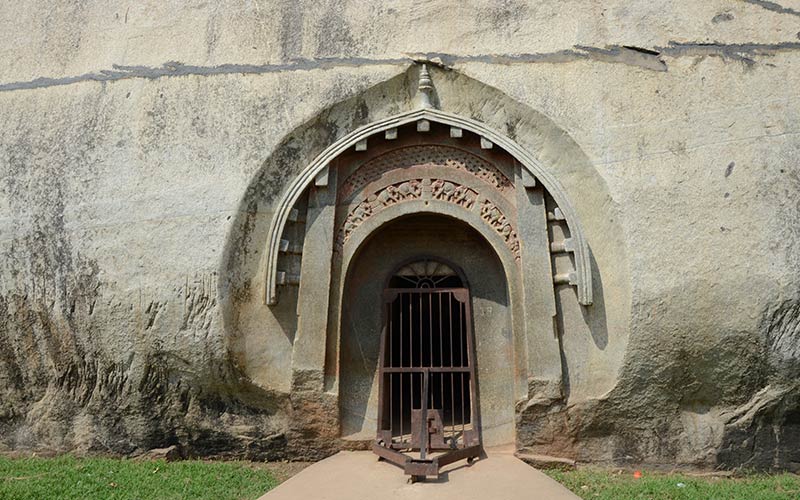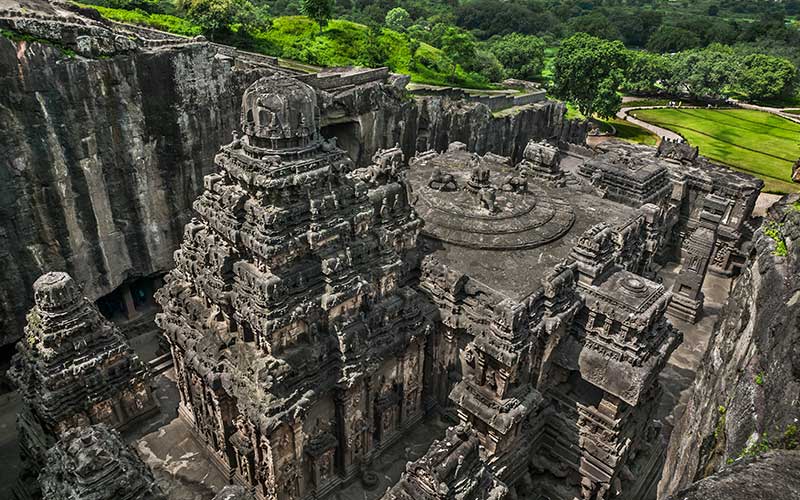Human Potential
What Archaeology Can Teach Us About Technology
Through their innovations, people and organizations go to places they never imagined. But as they break new ground, their innovations too often begin by following predictable patterns — ones that are visible only by looking at the underlying metastructures.
Even when paving a new path, people often want it to look just like the old one, all the way down to the same cobblestones and signposts. Perhaps that desire stems from a sense of comfort or, worse, a lack of imagination. This storyline can be seen in today’s virtual experiences, and it can be spotted just as easily in ancient architecture.
Barabar Caves
The Barabar Caves near Patna, in northeastern India, are among the country’s oldest rock-cut caves. These simple caves were carved in the fourth century BCE for monks. Their façade features two not-quite parallel columns that form a gateway.

These columns move closer together as they reach the top. That load-bearing design is critical for building with wood: It keeps the center of gravity in the base. But this form serves no practical purpose when it comes to carving a stone entrance.
The Barabar Caves were created when the preferred medium for ceremonial architecture was shifting from timber to rock. Although it calls for speculation, it appears that architects used a design from the old medium that they were familiar with, while moving to a new medium.
Virtual brick and mortar
Two and a half millennia later, corporations worldwide are facing comparable choices in a period of rapid transition. The traditional medium (brick and mortar) is giving way to virtual stores. As businesses decide how they will function in this increasingly digital world, they have too often rushed to simply create virtual avatars of brick-and-mortar experiences.
Virtual storefronts use the same familiar constructs: aisles, wheeled shopping carts, shelf displays, mannequins, and so on. Online conferences feature virtual registration desks, lobbies, walkways, halls, and auditoriums filled with digitally rendered seats and people. Online teachers use slides instead of a blackboard and present information in a window rather than from behind a podium, but they primarily do the same thing as in the analog world: They talk.
In short, we are re-creating the familiar, just as the ancient architects did in their early transitional stage. Meanwhile, we fail to ask the most basic question: Is this the best way to explore a new medium?
No, it isn’t.
When transitioning to the virtual world, the sooner we excise the compulsion to re-create brick-and-mortar features, the sooner we will be able to truly utilize the potential of the new medium. Only then will we be able to rid ourselves of the familiar and truly reimagine each of these experiences in our new world.
For example, features such as lobbies and reception desks came into existence due to a number of constraints: the need to make economical use of available real estate and the necessity of linear entry processes. These constraints do not exist in the virtual medium, where space is neither limited nor linear. The same is true of schooling, shopping, or any other experience. If we are to learn from the ancients, we must break away from their patterns. That is, we must let go of the traditional constructs that served us well in the past and figure out the new constructs that will serve us well in the future.
The virtual world offers limitless new possibilities that the brick-and-mortar world simply could not. Opportunities are available to rethink how customers view, select, buy, and pay for experiences and services. Engagement with employees, customers, students, and citizens needs to be completely reenvisioned. The sooner we do this, the sooner we will be able to realize the true benefits of this transitional time.
Despite their sometimes halted efforts, those early architects did eventually progress beyond their initial efforts to re-create the familiar. As time progressed, the master builders of antiquity realized that old limitations no longer existed, and they boldly explored new creative possibilities. Only then could they embrace new mediums wholeheartedly and create things that were not possible with old mediums.
A stunning example of this bold reimagining can be found at the eighth-century Kailasa Temple at Ellora in western India. The massive temple is carved out of a single monolith, a staggering artistic and engineering feat. It involved the removal of 150,000 to 200,000 tons of solid rock. The complex measures some 164 feet (50 meters) long, 108 feet (33 meters) wide, and 100 feet (30 meters) high. It still amazes visitors today. At the same time, it is completely free of any emotional attachment to timber in its design, features, or execution. It was imagined in rock and realized in rock.

For those artisans, however, time operated differently. The ancients had centuries to bring about change. We have weeks, or at best, a few months — if we are lucky. So how can we do this? We have found three guiding principles that help.
- Separate the essential from the familiar. Many features found in schools, offices, conference centers, and shopping malls are based on conventions borne out of constraints or necessities. They then become entrenched and familiar. When ridding ourselves of the old medium, it helps to go through a systematic exercise of separating the essential elements of the experience from those which are merely familiar. Deconstruct each assumption, and challenge whether that assumption should still be true in the virtual world. If not, it should be thrown out. For example, registration is an essential feature of a conference, but a ‘registration desk’ is only a familiar element — one that need not exist in the virtual world. Reimagine how the registration process should happen online.
- Let the virtual-native designers design. In his poem “On Children,” 19th-century writer Kahlil Gibran advised parents that children’s “souls dwell in the house of tomorrow, which you cannot visit, not even in your dreams.” This advice can apply just as easily to designers. Those who are fluent in a new medium are likely to see new opportunities that the previous generation cannot. Virtual-native designers are likely to reimagine experiences far better than those who look at the new medium grudgingly. Therefore, it makes sense to let virtual-native designers design the new experiences.
- Don’t ignore the learning curve. Change, no matter how welcome and how inevitable, is hard on people. When reimagining experiences, remember that taking away the familiar will likely induce stress. On top of this, not everyone is tech-savvy, so don’t underestimate how much learning will have to take place. New experiences should be as simple and intuitive as possible — always a good rule, but a particularly important one in times of rapid change. We should also overcommunicate and overdocument any new paradigm, to ensure users thoroughly understand the changes.
Despite its challenges, it is still important to make the transition to a true virtual paradigm. Not doing so would lead end users to believe they can expect old familiar experiences in the new virtual world. But this will not likely be true. The new medium will offer new strengths but may not necessarily offer the strengths of the old world.
Misleading users is unfair to them and also diminishes the opportunities presented by the new virtual world. Instead of seeing many possibilities on the horizon, users may encounter disappointment and stress. Signs of this stress are already evident in online schooling, an early adopter of technology but one in which both teachers and students are complaining about the lack of engagement.
As innovators and technologists, the sooner we get rid of the compulsion to re-create the familiar, and the sooner we dive into the new medium with an open mind, the sooner we can turn involuntary change into a great new opportunity.




